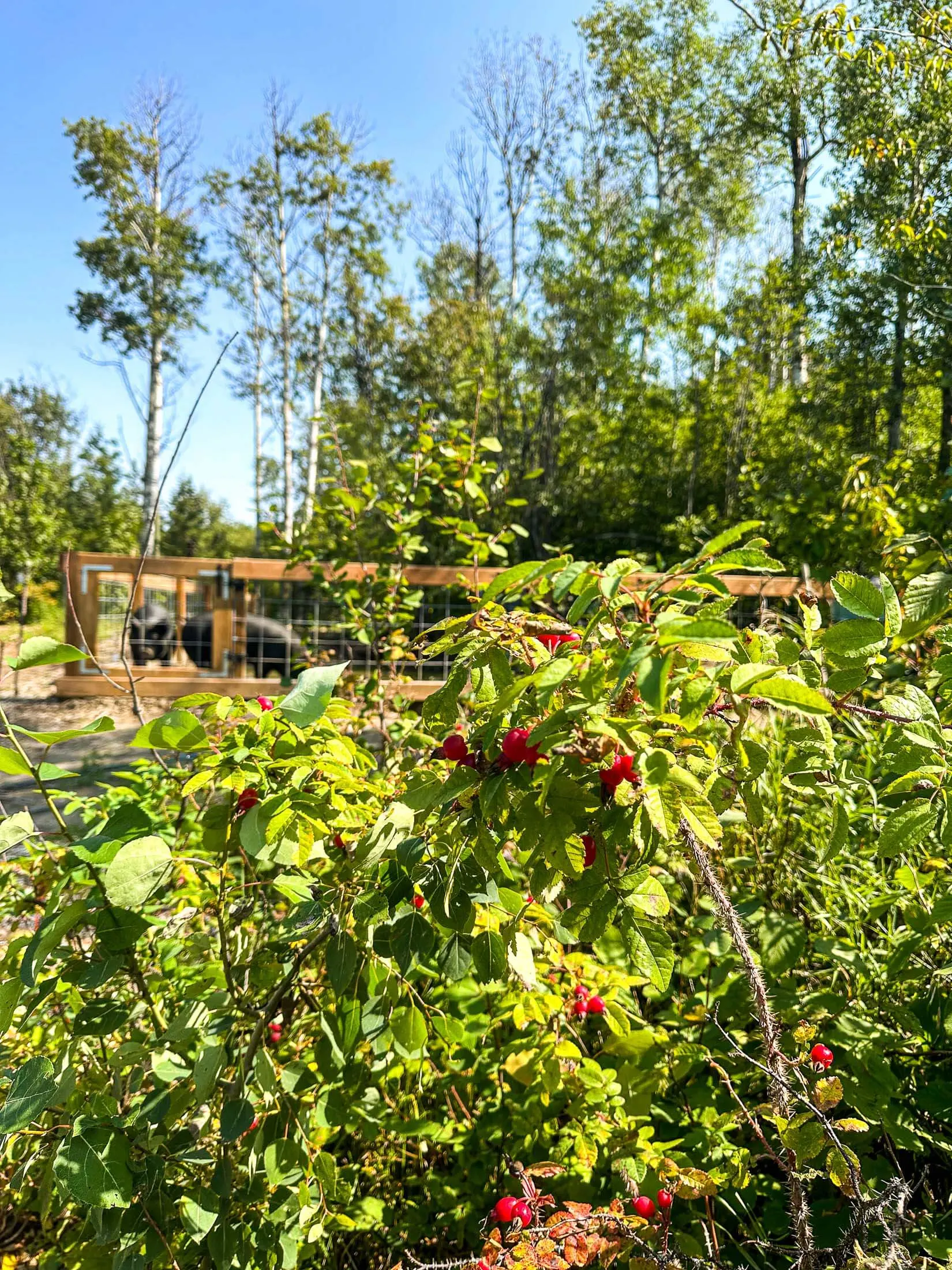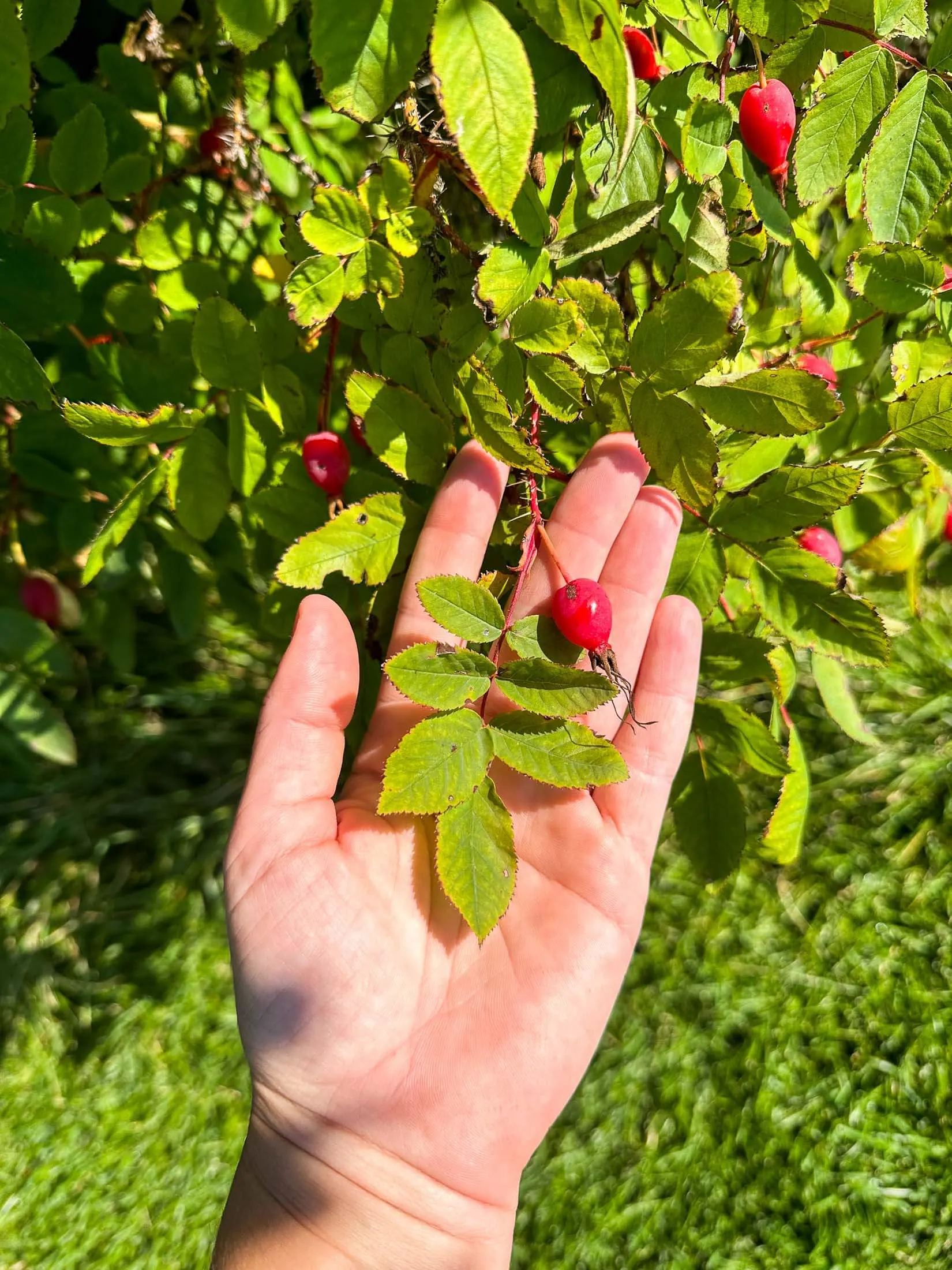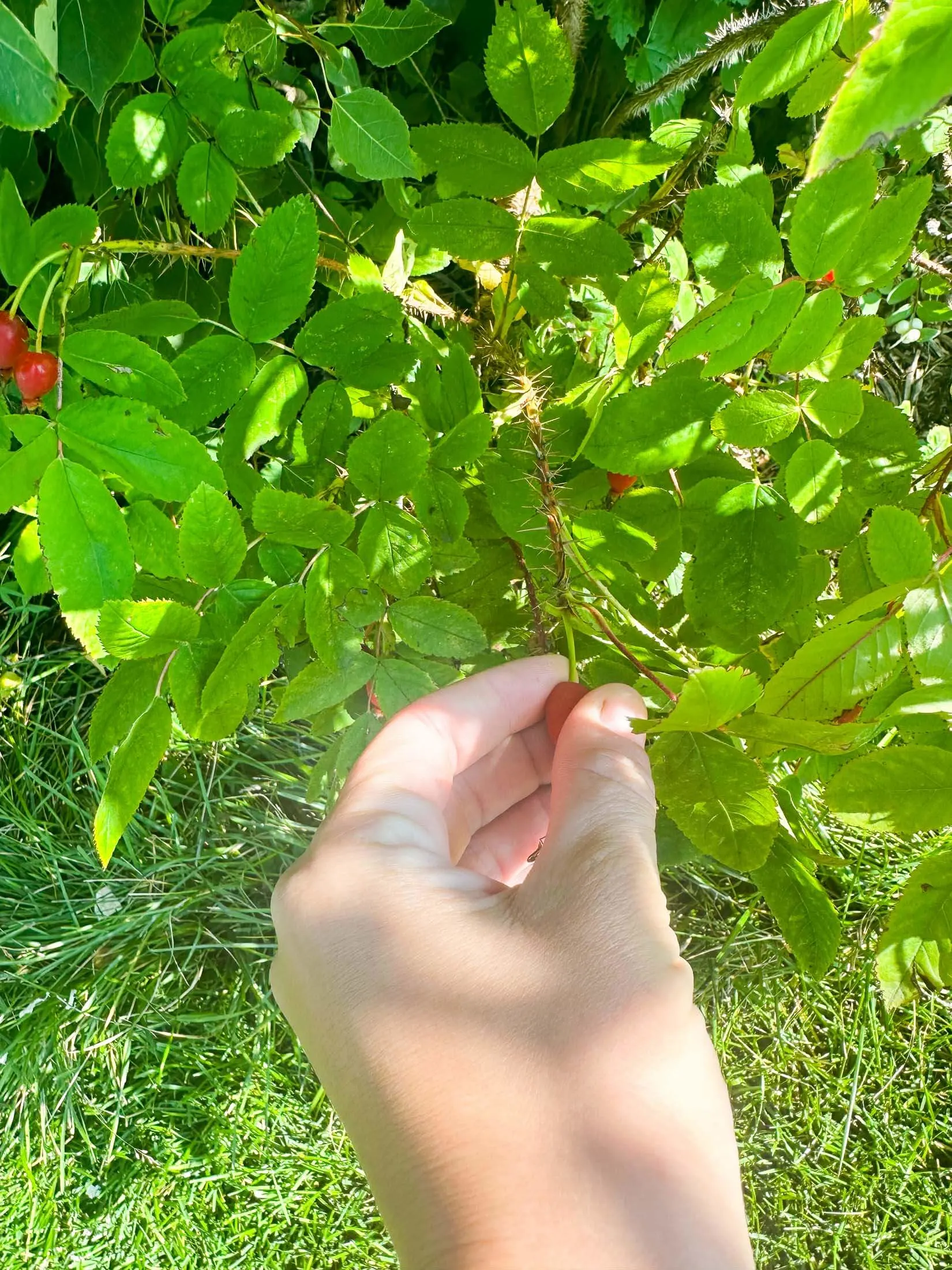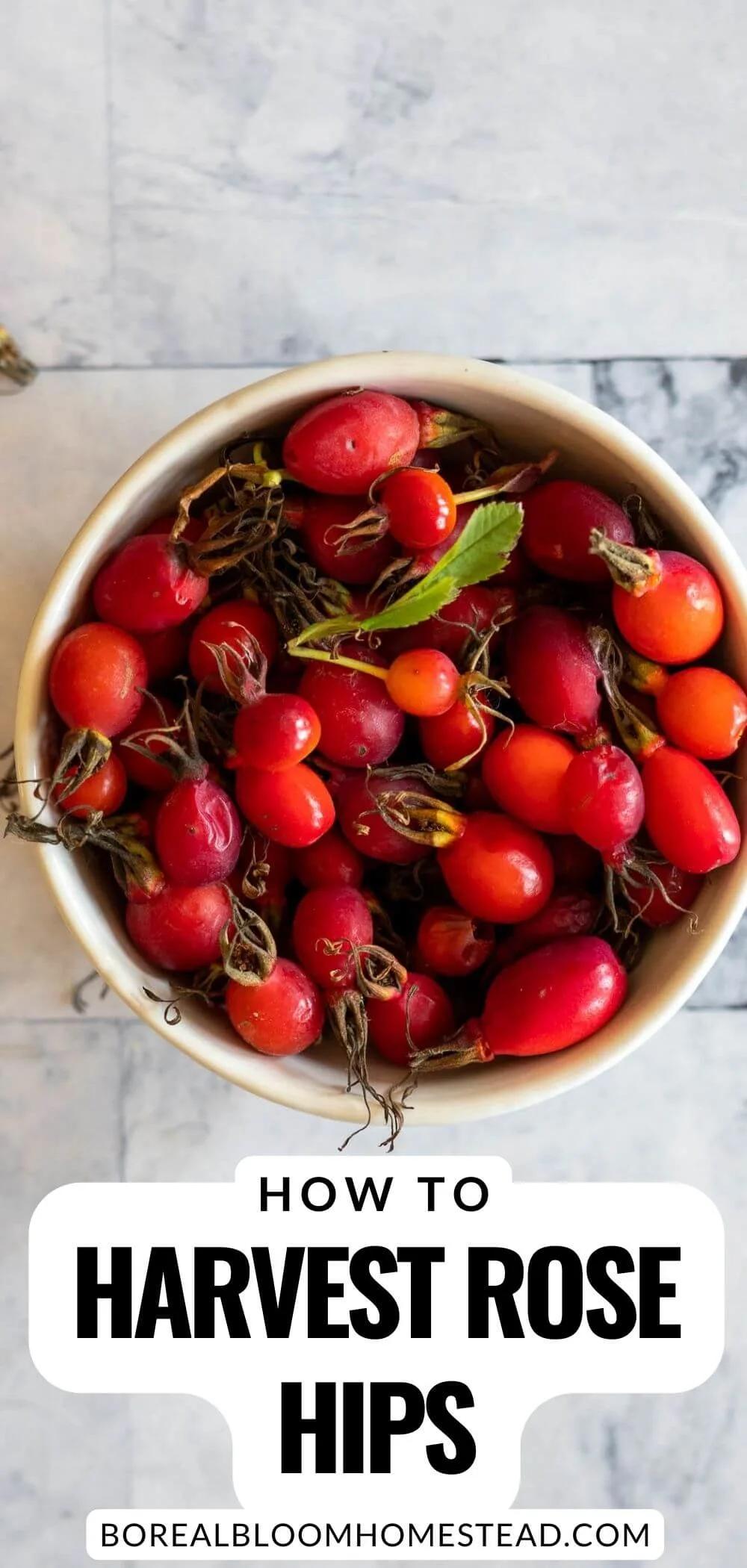We hail from wild rose country. Like, literally, Alberta's official flower is the prickly rose. It grows pretty much everywhere, and in the late summer - early fall, our boreal forest is studded with ruby colored rose hips.
We're fortunate enough that our entire property is absolutely littered with wild roses and we're able to harvest a ton of them without affecting the needs of the birds and other wildlife.
Those vibrant pink roses symbolize so much to me that I actually had a wild rose added to my blog logo - you can see it in the jar!

As an Amazon Associate I earn from qualifying purchases.
Jump to:
What Are Rose Hips?
Rose hips are the seed bearing fruit of rose plants. Also known as rose haws or rose heps, these fruit form once a flower fades and tend to ripen in late summer or early fall.
Rose hips are often bright red or orange but can present as deep purple and even black depending on the species and variety. These bright, berry sized fruits adorn roses long into the winter and are really easy to find once ripe.
Not only are rose hips edible to us humans, but they are also an important food source for wildlife. All rose hips can be eaten, but like other fruit, not all of them taste good!
Did you know: Rose hips contain tons of Vitamin C!! Some sources even claim that rose hips have more Vitamin C than oranges. Unfortunately, much of the vitamin is lost during the drying process.

What Kind Of Roses Make Rose Hips?
All types of roses make hips. BUT some are smaller, some are larger, some are tasty, and some are not.
Most modern roses are bred for large, showy flowers. In order to have many beautiful blossoms, these roses require deadheading to continue blooming abundantly. Unfortunately, rose hips only form once the flower has been pollinated and drops, but a stem that has been deadheaded will not produce a rose hip.
If you want to grow roses for hips, the best place to start would be heirloom roses or old garden roses like Grandma grew. Older varieties along with wild roses are fantastic at producing rose hips because their flowering habit does not require deadheading for continued blooming.
In my humble opinion, wild roses make gorgeous rose hips, so if you're in the market for rose hips, take a look along the edges of the forest, I bet you'll be surprised at how many wild rubies you'll find!
If you can't find rose hips, you can always order dried hips online! There are many options on the market, including cut and sifted or whole rose hips.

Foraging Best Practices
Foraging always leaves me feeling blessed and thankful to nature for providing abundance.
One of the ways I return the favor is by being respectful during harvesting - I take enough for myself but leave enough for the plant to continue to grow and propagate, as well as leave for the animals that may rely on the plant for food in the coming months.
Don't forget to consider the source! Harvest your rose hips in a safe location. Consider wildlife as well as chemical contamination. Hips found deep in the forest are more likely to increase encounters with wildlife, while harvesting near a busy roadway is more likely to increase chemical exposure from pollution and road maintenance.
Always avoid roses that have been sprayed with herbicides, pesticides, insecticides, etc. I know that any roses I forage on our homestead are free from chemicals, as we do not use any "cides" of any sort here.
If you love rose hips, consider planting a shrub rose in a food forest or flower bed, then you'll always know what chemicals have or haven't been used on the roses.

Identifying Wild Roses
If you're going out harvesting, it's important to know what a wild rose bush looks like. I'm using the prickly rose as an example because that is the most common wild rose here in Alberta.
Shape: Prickly rose plants have a shrubby growth habit, usually between 1 - 5 feet tall.
Stems: Prickly rose stems have weak bristles and slender thorns, the common wild rose lacks bristles and has fewer thorns.
Leaves: Rose leaves are compound in formation, usually with 3-9 leaflets. The leaves are 1-2 inches long with a double toothed margin which means each cut out tooth has a second, smaller tooth.
Flowers: Wild roses are easily identified by their flowers, which are 5 petaled, single, bright pink flowers. They range in size from 2 - 3 inches across and are centered around many yellow stamen. Depending on your area, wild roses should be in bloom between May and August.
Fruit: The fruit, or rose hips, range from spherical to pear shaped and are about 3/4 inch long and have 5 sepals protruding from the end. In between the sepals is hairy looking bits that are the remnants of anthers and filament. Rose hips are commonly orange to red, but can come in deep purple and even black.

How To Harvest Rose Hips
Generally when foraging I recommend scoping the plants in the spring to see their blooms, but rose hips are so easily identifiable and have no toxic look-a-likes that they can be scouted after the flowers drop.
Usually, the best time to harvest rose hips is after the first frost for a sweeter flavor. But if you're harvesting for herbal use versus food, they can be harvested whenever they are plump and juicy.
Harvest only bright red rose hips with smooth skin. They should give under a gentle squeeze.
Avoid overripe, shriveled hips as they are less flavorful and less fresh. These can be left behind for birds and animals.
Rose hips are ripe when they can be removed from the plant with a gentle tug.

How To Use Harvested Hips
Edible:
There are many many, ways to use your rose hips. They can be prepared for use in edible recipes:
Rose hips can even be eaten raw, though it's important to take care to avoid eating too many raw rose hips as it can cause diarrhea and irritation to the digestive tract. The seeds and tiny hairs within the rose hips should be scraped out as they can also cause irritation because they aren't broken down during the digestion process and can result in, for lack of better words, an itchy bum hole!
Herbal:
Rose hips have many benefits to our health and are often used medicinally and herbally in recipes like:
Rose hips have powerful antioxidant properties, though fresh rose hips have more antioxidants than dried. Rose hips are high in polyphenols which can help to reduce inflammation and joint pain. Rose hips' high Vitamin C content can make it a valuable immune booster.

Thoughts From The Homestead
Foraging and harvesting rose hips not only allows us to tap into the beauty of nature but also grants us access to a treasure trove of antioxidant-rich foods and herbal remedies.
By familiarizing ourselves with proper identification, adopting sustainable harvesting practices, and honing our knowledge on utilizing these precious hips, we open ourselves up to a world of possibilities. From delightful culinary creations to nourishing health elixirs, wild roses offer a bountiful array of benefits. Embrace the journey of connecting with nature and savor the abundance that awaits.
Pin This Guide To Harvesting Rose Hips


kienna A
Friday 12th of April 2024
where do you find the rose hips in alberta
Ally
Monday 15th of April 2024
Anywhere that you can find wild roses! Along nearly any fence line in the country should have wild roses. I recommend taking a little drive to see if you can find them while the roses are blooming and then you'll be able to find the hips easier when the flowers fall off.